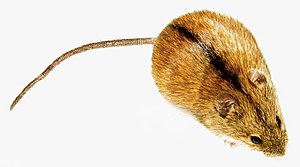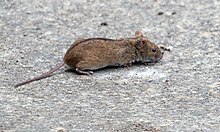Firemouse
| Firemouse | ||||||||||||
|---|---|---|---|---|---|---|---|---|---|---|---|---|

Fire mouse ( Apodemus agrarius ) |
||||||||||||
| Systematics | ||||||||||||
|
||||||||||||
| Scientific name | ||||||||||||
| Apodemus agrarius | ||||||||||||
| ( Pallas , 1771) |
The fire mouse ( Apodemus agrarius ) is a species of mammal from the family of long-tailed mice (Muridae). This relatively small and short-tailed long-tailed mouse occurs in two separate areas from eastern Central Europe to eastern China and Taiwan. It inhabits predominantly moist habitats with rich cover and is also common in parks and gardens in Central Europe. According to the IUCN, the species is not endangered.
features
The fire mouse belongs to the smaller species of the genus Apodemus , the tail is relatively short and the ears are smaller than those of other members of the genus. The head-trunk length is 75–115 mm, the tail length 60–92 mm, the length of the hind foot 16–21 mm and the ear length 10–13 mm. The animals weigh 14-35 g. The fur is warm red-brown on top, grayish brown only in young animals. A narrow black stripe ( eel line ) runs across the middle of the back and extends from the neck to the rear of the back. The underside is gray-white. The females have four mammary glands .
distribution
The distribution area of the fire mouse covers large parts of the Palearctic in two separate sub-areas . The western subarea extends in a west-east direction from eastern Central Europe and northern Italy to the east near Lake Baikal and the northwest of the People's Republic of China , although the species is absent in large parts of south-eastern Central Europe. The north-western limit of distribution runs through Germany roughly along a line from the lower reaches of the Weser in east Westphalia , across the lower Werra in eastern Hesse and in southwest Germany north of the Main in the Münnerstadt area across north-eastern Upper Franconia and the Ore Mountains . In north-south direction, the European area stretches from southern Finland to northern Greece .
The eastern subarea includes the southern parts of the Far East of Russia in the north , extends south to Korea and China to around 25 ° N and includes Taiwan .
habitat
The fire mouse inhabits mostly moist habitats such as forest edges, bushes, damp meadows and reed beds, but also - and apparently increasingly - gardens and parks. It mainly inhabits lowlands, but occurs in Macedonia up to an altitude of 1750 m. In summer the species also colonizes grain fields, in winter it is often found in barns and similar buildings.

Way of life
Fire mice are predominantly diurnal. The animals jump and climb less well than other species of the genus and usually stay on the ground. The diet consists of seeds and fruits, but also to a large extent of insects and their larvae, snails and worms.
Reproduction takes place from April to September. The gestation period is 18 to 21 days. The litters include 4 to 9, usually 6 to 7 young. The eyes open at the age of 9 to 12 days, after 8 weeks the young are sexually mature.
Depending on the habitat, the settlement density varies between 5 and 50 individuals per hectare; it is lowest in forests and highest in urban green spaces. Occasionally, mass reproductions occur.
The fire mouse as a disease vector
The fire mouse has been identified as a carrier of hantaviruses : the Dobrava virus in central and northeastern Europe and the Hantaan virus in Asia .
Existence and endangerment
The species is significantly more common in the east of its range than in the western part, in the area of the north-western limit of distribution there is also evidence of a reduction in the area. On the other hand, the Brandmaus has only expanded its area into southern Austria in the last few decades. The world herd is loud IUCN as not at risk ( "least concern"), and in Germany the way in which it is red list out as not at risk.
swell
literature
- Stéphane Aulagnier, Patrick Haffner, Anthony J. Mitchell-Jones, François Moutou, Jan Zima: The mammals of Europe, North Africa and the Middle East. The destination guide. Haupt, Bern et al. 2009, ISBN 978-3-258-07506-8 , pp. 228-229.
- Anthony J. Mitchell-Jones, Giovanni Amori, Wieslaw Bogdanowicz, Boris Krystufek, PJH Reijnders, Friederike Spitzenberger, Michael Stubbe, Johan BM Thissen, Vladimiŕ Vohralik, Jan Zima: The Atlas of European Mammals. Poyser, London, 1999, ISBN 0-85661-130-1 , pp. 266-267.
- Erwin Stresemann (founder), Konrad Senglaub (ed.): Excursion fauna of Germany. Volume 3: Vertebrates. 12th, heavily edited edition. G. Fischer, Jena et al. 1995, ISBN 3-334-60951-0 , pp. 413-414.
Individual evidence
- ^ The fire mouse on the IUCN Red List, with distribution map
- ↑ Robert Koch Institute : Profiles of rare and imported infectious diseases ( Memento of the original from August 26, 2016 in the Internet Archive ) Info: The archive link was inserted automatically and has not yet been checked. Please check the original and archive link according to the instructions and then remove this notice. , P. 19
Web links
- Apodemus agrarius in the endangered Red List species the IUCN 2008. Posted by: Kaneko, Y. et al, 2008. Accessed 21 February 2009..
